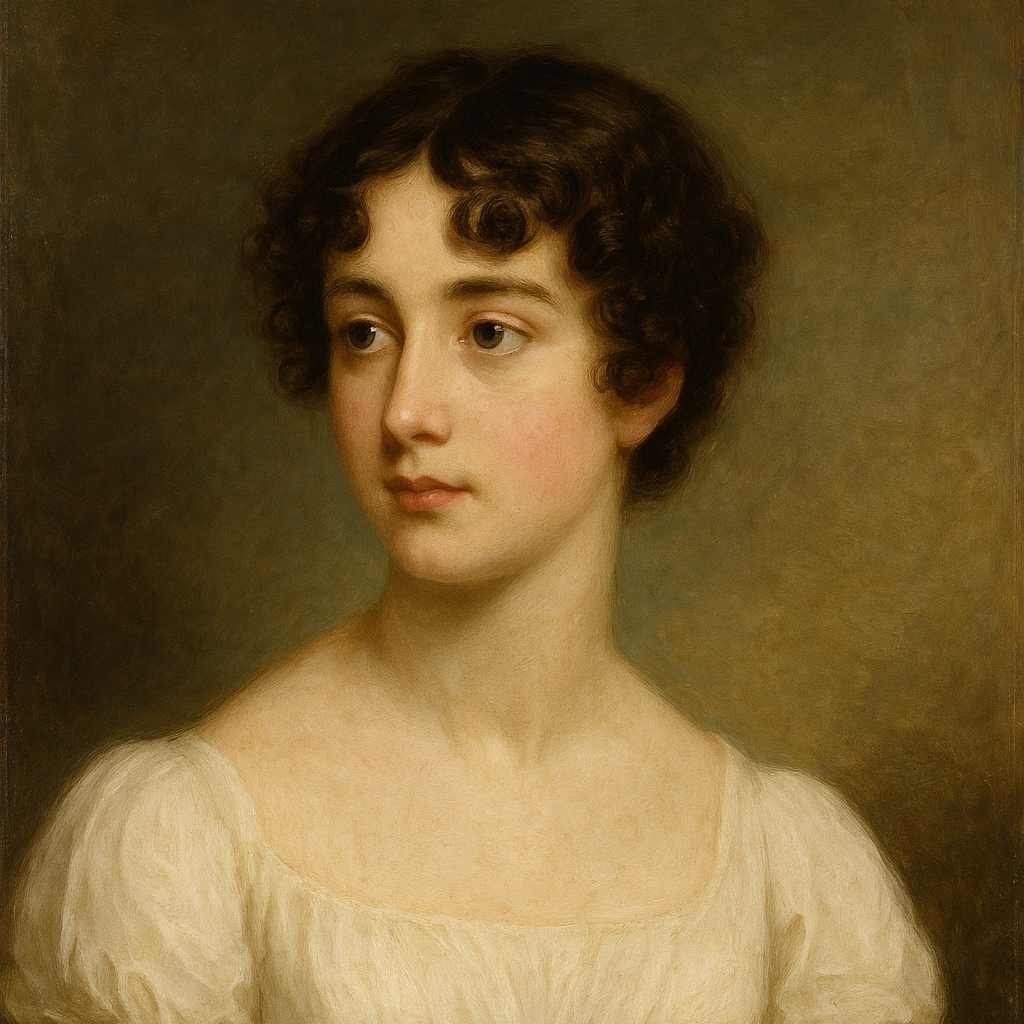Revenge
Letitia Elizabeth Landon
1802 to 1838

Ay, gaze upon her rose-wreathed hair,
And gaze upon her smile;
Seem as you drank the very air
Her breath perfumed the while:
And wake for her the gifted line,
That wild and witching lay,
And swear your heart is as a shrine,
That only owns her sway.
’Tis well: I am revenged at last,—
Mark you that scornful cheek,—
The eye averted as you pass’d,
Spoke more than words could speak.
Ay, now by all the bitter tears
That I have shed for thee,—
The racking doubts, the burning fears,—
Avenged they well may be—
By the nights pass’d in sleepless care,
The days of endless woe;
All that you taught my heart to bear,
All that yourself will know.
I would not wish to see you laid
Within an early tomb;
I should forget how you betray’d,
And only weep your doom:
But this is fitting punishment,
To live and love in vain,—
Oh my wrung heart, be thou content,
And feed upon his pain.
Go thou and watch her lightest sigh,—
Thine own it will not be;
And bask beneath her sunny eye,—
It will not turn on thee.
’Tis well: the rack, the chain, the wheel,
Far better hadst thou proved;
Ev’n I could almost pity feel,
For thou art not beloved.
Letitia Elizabeth Landon's Revenge
Introduction
Letitia Elizabeth Landon's poem "Revenge" presents a complex tapestry of emotions, weaving together themes of betrayal, heartbreak, and the bittersweet satisfaction of retribution. This early 19th-century work exemplifies the Romantic period's preoccupation with intense emotion and the intricate workings of the human heart. Through its vivid imagery and masterful use of poetic devices, Landon crafts a narrative that resonates with the universal experience of love lost and the desire for emotional justice.
Historical and Literary Context
Landon, known by her initials L.E.L., was a prominent figure in London's literary circles during the 1820s and 1830s. Her work often focused on themes of love, betrayal, and the female experience in a society that placed strict limitations on women's roles and expressions of desire. "Revenge" can be seen as a product of its time, reflecting the Romantic era's emphasis on individual emotion and the exploration of the human psyche.
The poem's structure—six quatrains of alternating rhyme scheme (ABAB)—provides a rhythmic foundation that mirrors the ebb and flow of the speaker's emotional journey. This formal choice allows Landon to create a sense of controlled passion, where the speaker's feelings are intense yet contained within the boundaries of poetic form.
Analysis of Poetic Devices
Landon employs a rich array of poetic devices to enhance the emotional impact of "Revenge." The use of apostrophe is particularly striking, as the speaker directly addresses both the former lover and her own heart. This rhetorical device creates an intimate tone, drawing the reader into the speaker's private world of pain and triumph.
Imagery plays a crucial role in the poem's effectiveness. The opening stanza presents a tableau of the new object of the former lover's affection, with "rose-wreathed hair" and a perfumed breath that seems to infuse the very air. This sensual imagery serves as a stark contrast to the bitterness that follows, heightening the emotional tension of the piece.
The poet's use of alliteration and assonance further enriches the sonic texture of the work. Lines such as "The eye averted as you pass'd" demonstrate how Landon employs these techniques to create a musicality that underscores the poem's emotional resonance.
Thematic Exploration
At its core, "Revenge" is an exploration of the complex emotions that follow betrayal in love. The speaker's journey from victim to victor is charted through the progression of the stanzas, each building upon the last to create a narrative arc of empowerment through suffering.
The concept of revenge itself is multifaceted in Landon's treatment. It is not a violent or active form of retribution that the speaker seeks, but rather a passive satisfaction in witnessing the former lover's new romantic failure. This nuanced approach to revenge speaks to a deeper psychological truth—that the healing of a wounded heart can sometimes find solace in the misfortunes of those who caused the initial pain.
The poem also delves into the theme of emotional authenticity. The speaker contrasts her own genuine suffering with the superficial nature of the former lover's new pursuit. Lines such as "And swear your heart is as a shrine, / That only owns her sway" drip with irony, suggesting that the lover's declarations are as hollow as they are grandiose.
Gender Dynamics and Power
It is crucial to consider "Revenge" within the context of 19th-century gender dynamics. Landon presents a female speaker who, despite her initial victimhood, ultimately claims a position of power. This empowerment through emotional resilience and the ability to witness the downfall of her betrayer subverts traditional narratives of female passivity in the face of romantic disappointment.
The poem's conclusion, with its vivid imagery of "the rack, the chain, the wheel," invokes the language of physical torture to describe emotional pain. This conflation of the physical and emotional realms underscores the intensity of the speaker's past suffering while also suggesting that the tables have turned—now it is the former lover who will experience a form of psychological torment.
Stylistic Analysis
Landon's stylistic choices in "Revenge" are worthy of close examination. The poem's diction ranges from the elevated ("gifted line," "witching lay") to the more direct and emotionally raw ("bitter tears," "endless woe"). This variation in register allows the poet to capture both the societal expectations of refined expression and the visceral reality of heartbreak.
The use of enjambment throughout the poem creates a sense of momentum, propelling the reader forward through the speaker's emotional narrative. This technique is particularly effective in the fourth stanza, where the line breaks emphasize the relentless nature of the speaker's past suffering: "By the nights pass'd in sleepless care, / The days of endless woe;"
Comparative Context
"Revenge" can be productively compared to other works of the Romantic period that deal with themes of love and betrayal. While poets like Lord Byron often explored these topics from a male perspective, Landon's work provides a crucial female voice in the conversation. Her approach to revenge as a form of emotional satisfaction rather than physical action offers an intriguing counterpoint to more violent or melodramatic treatments of the theme in contemporary literature.
Critical Reception and Legacy
The reception of Landon's work, including "Revenge," has evolved significantly since her time. Initially praised for her passionate verse, she later faced criticism for what some viewed as overly sentimental or morally questionable themes. However, modern scholarship has led to a reevaluation of Landon's contributions to English literature, recognizing her skill in navigating the constraints placed on female writers of her era while still producing work of significant emotional depth and technical proficiency.
Conclusion
"Revenge" stands as a testament to Letitia Elizabeth Landon's poetic craftsmanship and her keen insight into the human heart. Through its carefully constructed verses, the poem offers a nuanced exploration of love, betrayal, and the complex nature of emotional healing. Landon's ability to capture the tension between societal expectations and raw human emotion creates a work that continues to resonate with readers, inviting us to reflect on the universal experiences of heartbreak and the sometimes conflicting desires for both justice and peace in matters of the heart.
In its exploration of revenge as a form of emotional closure, the poem raises important questions about the nature of healing and the cyclical nature of pain in romantic relationships. Landon's work challenges us to consider the costs and benefits of seeking satisfaction in another's misfortune, even as it acknowledges the very human impulse to do so.
Ultimately, "Revenge" serves not only as a powerful emotional statement but also as a significant contribution to the canon of Romantic poetry. Its enduring appeal lies in its ability to speak to the complexities of human relationships and the internal struggles we face in the aftermath of betrayal, making it a work worthy of continued study and appreciation in the field of English literature.
This text was generated by AI and is for reference only. Learn more
Want to join the discussion? Reopen or create a unique username to comment. No personal details required!



Comments
No comments yet. Be the first to comment!